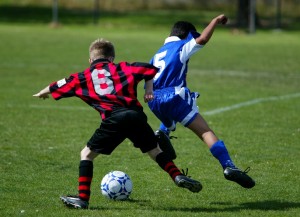 Seattle Children’s clinicians do everything they can to accurately diagnose concussions and recommend the most appropriate treatment. But those tasks are difficult without definitive diagnostic tools to determine when concussions have occurred or objective evidence to prove which treatments are best.
Seattle Children’s clinicians do everything they can to accurately diagnose concussions and recommend the most appropriate treatment. But those tasks are difficult without definitive diagnostic tools to determine when concussions have occurred or objective evidence to prove which treatments are best.
To provide better care, physicians need better research. That is why Seattle Children’s Research Institute has created the Youth Concussion Research Program.
The new program, made possible by a generous $5 million gift from The Satterberg Foundation, is designed to develop new concussion diagnostic tools; measure sports impacts using real-time sensors; and begin clinical trials to determine which concussion treatments are most effective.
“There are so many people who want to know how to prevent concussions and long-term effects,” said Frederick Rivara, MD, MPH, who will lead the Youth Concussion Research Program. “I hope we will soon be able to answer a lot of their questions.”
Between 1.6 and 3.8 million sports and recreational concussions occur in the United States each year. In the past, Seattle Children’s partnered with Harborview Medical Center to create the clinical Seattle Sports Concussion Program, providing the best care possible for these injuries. But experts continued to question concussion diagnosis and treatment, prompting the need for a concussion research program.
“We use clinical expertise to diagnose concussions but we could be better,” said Stanley Herring, MD, co-medical director of the sports concussion program. “If we can combine our expertise with other information that can be measured on injured athletes then that would be helpful.”
Unlike other concussion research programs, which typically focus on collegiate or professional athletes, Seattle Children’s will use the data from its clinical program to study concussions in children.
“A lot is still unknown about concussions, especially in younger kids,” Rivara said. “Their brains are undergoing enormous changes during childhood and adolescence, but we don’t know if concussions in the developing brain differ from mature brains.”
Seeking better diagnostics
There is currently no objective test to prove if an injury qualifies as a concussion. Standard imaging – such as a CT or MRI, and routine blood tests – rarely reveal signs of a brain injury. Without a definitive diagnosis doctors struggle to accurately identify concussions or determine how long the brain is vulnerable to reinjury.
The Youth Concussion Research Program will address these challenges by searching for concussion biomarkers, which will be used with advanced imaging to track patients over time to better understand who is at risk for significant concussion affects.
Seattle Children’s researchers will also use tiny sensors to discover how intense impact must be for a child to have a concussion. The Youth Concussion Research Program has partnered with Seattle-based X2 Biosystems, which developed a sensor that can be placed behind an athlete’s ear and detect forces to the head and brain. A sideline computer displays the sensor’s signal in real time and stores the information.
While similar sensors have been used in the football helmets of college and professional players, the X2 Biosystems sensors will also be able to record impacts in sports where helmets are not worn, such as soccer or basketball for both boys’ and girls’ sports. Researchers will use the sensor data to help determine what type and magnitude of forces are most likely to result in concussions in younger athletes.
Additionally, the sensors will be able to alert healthcare providers when a player has suffered a head injury that might result in a concussion without relying on the child to report it.
“We need to better understand the true prevalence of concussions in children,” Rivara said. “There is a whole culture in sports that does not want to recognize concussions as injuries, so kids don’t always report them.”
Finding the best treatment
Just as diagnosing a concussion is difficult, determining the most effective treatment is also challenging for physicians due to a lack of objective research. While the standard treatment is physical and relative mental rest, there is limited data to support these recommendations.
Seattle Children’s researchers hope to identify the most effective treatment for concussion by leading randomized controlled trials to find out when children should return to mental and physical activities and if rehabilitation is appropriate. This will help physicians treat sports concussions as well as brain injuries resulting from car accidents or other trauma.
“We want kids to live active lives but keep their brains healthy too,” Rivara said.
Study participants will come from the Seattle Sports Concussion Program, Seattle Children’s Hospital and teams in the community.
“If we want to research concussions and improve outcomes we have to go where they are occurring – in the communities,” said Dimitri Christakis, MD, MPH, director of the Center for Child Health, Behavior and Development at Seattle Children’s Research Institute. “We have a very supportive community that we hope will participate enthusiastically in this project.”
If you are interested in supporting the Youth Concussion Research Program contact Erika Kreger at [email protected].
If you would like to arrange an interview with Dr. Fred Rivara please contact Seattle Children’s PR team at 206-987-4500 or [email protected].
Resources:
- Seattle Sports Concussion Program
- Signs and Symptoms of Concussion

